 The art of storytelling relies on a series of events leading up to a heroic moment with a main character who audiences can relate to. This is a simple concept if one is selling watches, or cars, or soft drinks. But who wants to see himself in the center of a story about illness? Patients and physicians who can see themselves as the hero in the story overcoming health adversity to provide better care for themselves or others, that’s who.
The art of storytelling relies on a series of events leading up to a heroic moment with a main character who audiences can relate to. This is a simple concept if one is selling watches, or cars, or soft drinks. But who wants to see himself in the center of a story about illness? Patients and physicians who can see themselves as the hero in the story overcoming health adversity to provide better care for themselves or others, that’s who.
“If we think about who our customers’ products ultimately impact and the illnesses those products treat, the richest stories we could ever encounter flow from the times and ways in which those products enter HCPs’ and patients’ lives," says Chris Ryan, creative director, Avant Healthcare.
While nobody wants to see themself as the sick person in an ad, they will want to be the hero who finds a resolution to their 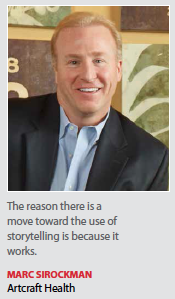 own or their loved one’s health challenges.
own or their loved one’s health challenges.
“The right story will find that insight or truth about the audience that they can relate to," says Tom Donnelly, managing director, Evoke Health. “And once they are invested, we can demonstrate how the brand can be a partner and help them overcome their challenge."
For example, recent research by Evoke Health discovered that patients with chronic pain were tired of focusing on the pain itself, and they wanted to see themselves in a place of empowerment instead of as a victim. Evoke Health marketers took this information and created a story that resonated with that mindset. The brand story gave patients the strength they needed to succeed and live their lives — without focusing on the negative.
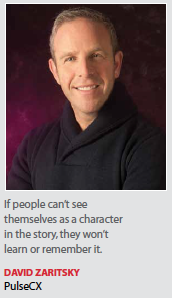 “This insight drove our creative, which we told with messaging and imagery that shows patients in control over their situation, no matter how impossible it may seem; the story we told helped make the emotional connection," Mr. Donnelly says. “Immediate reaction in user testing was an overwhelming success. This was the story they wanted to hear."
“This insight drove our creative, which we told with messaging and imagery that shows patients in control over their situation, no matter how impossible it may seem; the story we told helped make the emotional connection," Mr. Donnelly says. “Immediate reaction in user testing was an overwhelming success. This was the story they wanted to hear."
In the current pharma world of commodity products and ever-tightening regulations on brand promotion, to make an impact, marketers need to tell a product story — one that transcends the features and benefits of a product and shows how the product will influence the patient’s whole treatment experience.
“Like all good stories, our stories always begin with a setup of the conflict — the challenges a patient faces — and end with a believable resolution," says Nicole Hyland, senior VP/chief marketing officer, Natrel. “That resolution, especially in the case of chronic diseases, involves helping patients accept a modification to their lifestyle that will allow them to live as healthy a life as possible."
What makes a product story most compelling, however, is its ability to reach beyond the facts, beyond the intellect, and grab the heart of the decision maker, because even in medicine, decisions are based as much on emotion as on rational thought, she says. Just as the most affecting stories in novels and movies have a voice that adds emotion to the tale, the most successfully promoted brands have their own voice, or personality, that brings the story memorably to life.
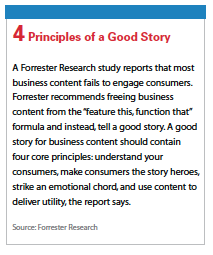 The power of storytelling is no secret. Neuroscientists have proven time and again that stories stimulate our brains. Anthropologists have identified storytelling as a universal feature of every culture and every country. Any of us can hold court with a good story at a cocktail party; but brand managers may struggle with bringing those same elements into brand marketing. Thought leaders say there are several factors driving a renewed interest in storytelling for pharma brands.
The power of storytelling is no secret. Neuroscientists have proven time and again that stories stimulate our brains. Anthropologists have identified storytelling as a universal feature of every culture and every country. Any of us can hold court with a good story at a cocktail party; but brand managers may struggle with bringing those same elements into brand marketing. Thought leaders say there are several factors driving a renewed interest in storytelling for pharma brands.
The proliferation of digital channels and the many more places people connect to share stories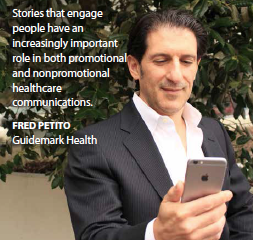 create an environment ripe for storytelling. According to content marketing platform OneSpot, Americans consume more than 100,000 digital words every day and 92% of them want to experience these words in the form of a story.
create an environment ripe for storytelling. According to content marketing platform OneSpot, Americans consume more than 100,000 digital words every day and 92% of them want to experience these words in the form of a story.
Of the three pillars to successful storytelling — context, content, and connectivity — the availability of contextual and personal relevance has become the game changer for pharmaceutical marketers, says Croom Lawrence, senior director, customer experience lead, health, at Merkle. Being able to analyze audience data and target patients through data-driven methods allow for hyper-targeted, personalized messages. According to Mr. Lawrence, it has only been in the past 12 to 24 months that the capabilities for driving personal experiences have emerged from the availability of big data.
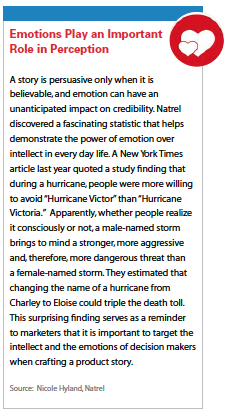 “There has been an explosion of addressable media, marketing innovation, and identity recognition that’s giving us the ability to do mass storytelling at scale," he says.
“There has been an explosion of addressable media, marketing innovation, and identity recognition that’s giving us the ability to do mass storytelling at scale," he says.
This gives brands today an energized role to play through marketing automation, which delivers a more personalized experience across all devices and across all platforms.
“The value between a brand and its audience increases through personalization," Mr. Lawrence says.
To encourage storytelling among like-minded patients and create a place for learning from other patients’ experiences, Health Perspectives Group designed Health Stories Project. The goal is to provide support to help people become more engaged and informed in their health choices.
“The complexity of pharma product information, combined with the emotional trauma 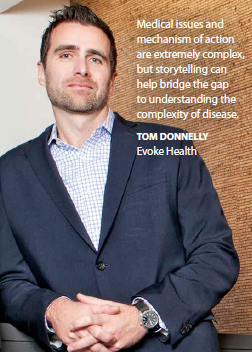 associated with illness and diagnosis, as well as the patient’s more empowered role in his or her healthcare, can all be addressed successfully through good storytelling," says Cheryl Lubbert, president and CEO of Health Perspectives Group and co-founder, Health Stories Project. “Research shows that 78% of consumers trust recommendations from peers, and 63% of consumers believe pharma information from peers is credible, even if the peers are not experts. When these statistics are combined with an understanding of how the brain processes stories, it’s clear that delivering information in the form of stories from real, authentic users of products — shared in a compliant way — is the most effective strategy to build a lasting connection with a target audience."
associated with illness and diagnosis, as well as the patient’s more empowered role in his or her healthcare, can all be addressed successfully through good storytelling," says Cheryl Lubbert, president and CEO of Health Perspectives Group and co-founder, Health Stories Project. “Research shows that 78% of consumers trust recommendations from peers, and 63% of consumers believe pharma information from peers is credible, even if the peers are not experts. When these statistics are combined with an understanding of how the brain processes stories, it’s clear that delivering information in the form of stories from real, authentic users of products — shared in a compliant way — is the most effective strategy to build a lasting connection with a target audience."
Marc Sirockman, executive VP, Artcraft Health, gets right to the point: “The reason we are seeing a move toward more use of storytelling is because it works."
“We are seeing a move toward more disease-state education through storytelling because it is a lot easier to understand," he says.
Stories are easier to comprehend and remember because the emotional response helps the brain break down complex concepts.
“The story acts as a device to explain something much more complicated," Mr. Donnelly says. “These stories can activate up to seven areas of the human brain; listeners experience a story, rather than just trying to process a lot of information."
A story line can also help consumers sift through the sheer volume and diversity of health information that is now available online and identify the information that is most relevant to their condition.
“There is a lot of good that can come out of today’s increased access to information," says Fred Petito, chief customer engagement officer, Guidemark Health. “However, one paradox of all this access is that when people are presented with too much data, there is a risk they will become overwhelmed and paralyzed in their decision-making process."
In the past, pharma marketing leaders have been hesitant to create stories around disease and medicine, thinking such topics are too serious for storytelling.
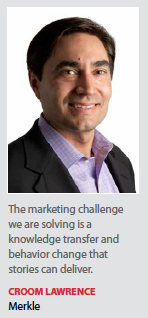 “Storytelling has such an old and honored history, its power speaks for itself," Mr. Ryan says. “Many pharma clients had previously considered a storytelling approach to be too unscientific for delivery of medical messages. They forgot that the heart helps engage the brain."
“Storytelling has such an old and honored history, its power speaks for itself," Mr. Ryan says. “Many pharma clients had previously considered a storytelling approach to be too unscientific for delivery of medical messages. They forgot that the heart helps engage the brain."
The Health Stories Project gets to the heart of the matter, and the results prove storytelling is a viable means of relaying pertinent health information.
“Feedback we have received from those who share their stories and those who hear them has shown the value of these connections," Ms. Lubbert says. “Stories take away the fear. People don’t feel as alone."
In health and wellness marketing, there is always an underlying story of good versus evil, or triumph of the human spirit, Mr. Donnelly says.
“It’s about the struggle to overcome something that appears to be insurmountable, whether it is dry skin or a much more serious, life-threatening condition or rare disease," he says. “This conflict is part of the human experience and it’s a story that we all know — it’s David versus Goliath."
“Storytelling is in our DNA," says David Zaritsky, president, PulseCX. “But storytelling for marketing is more than just an entertaining tale; if people can’t see themselves as a character in the story, they won’t learn or remember it. If consumers can put themselves into the story, and see the positive outcome played out by the characters, they become emotionally invested. Once they are emotionally invested, they become engaged."
Telling the Best Story
Marketers need to know and understand the target audience if they are to create a story that resonates with them. Understanding patients starts with listening to them. Once their experiences have been identified, a brand message can be 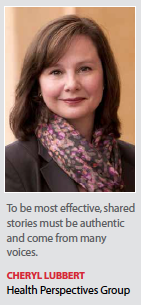 communicated from the audience’s perspective and become part of a patient’s own story. This iterative messaging evolves throughout the patient journey, touching on various points from pre-diagnosis to post.
communicated from the audience’s perspective and become part of a patient’s own story. This iterative messaging evolves throughout the patient journey, touching on various points from pre-diagnosis to post.
When creating stories for marketing there needs to be different stories for each stage of the patient journey. A savvy marketer will create a story with an experiential or spiritual impact during not one but all the different important moments along the patient experience.
“There should be a story that resonates at the time of treatment, at diagnosis, at pre-diagnosis, etc., and therefore no matter where the patient is he or she can relate to the character at any entry point," Mr. Zaritsky says.
Mr. Sirockman agrees consumers want fresh stories along their journey.
“Pharma marketers needs to give new content for each patient stage," Mr. Sirockman says. “This will allow for better retention of the material, which increases compliance, and the end result is a better educated patient."
To resonate best with real patients, stories need to come from the heart, and be sincere.
“Most medical material is designed to appeal to people on a rational level," Mr. Petito says. “Whereas logic and reason are important in any decision-making situation, there are limits to how far a person’s reasoning will take him or her. This is especially true in the highly personal and emotional context of healthcare.
Research has shown time and again that emotional responses to advertising messages not only function independently of cognitions, but also can actually override them. For this very reason, storytelling, and the power of stories to engage people in familiar and emotional ways, plays a critical role in both promotional and nonpromotional healthcare communications. If used correctly, stories can engage people in deeper and more meaningful ways to drive responses that are based on emotions such as empathy and compassion. These are very powerful motivators and when matched with more rational decision-making processes can be a very effective combination to drive better decisions for all stakeholders."
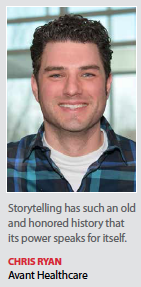 While most of our thought leaders focused on the brand messaging for patients, storytelling is just as applicable for healthcare providers.
While most of our thought leaders focused on the brand messaging for patients, storytelling is just as applicable for healthcare providers.
“Healthcare professionals are no different from the rest of us; if we don’t capture their attention — or if we capture it and then put them right to sleep — they will tune out and we will have failed to create the environment and experiences that open their minds to think and, ultimately, act differently," Mr. Ryan says. “In our industry, storytelling is about stretching ourselves beyond cramming graphs and dense copy into 125 PowerPoint slides and calling it a day."
Enhancing the experience through the other senses arms marketers with a powerful menu of raw ingredients from which they can craft an even more powerful story. Mr. Ryan says there is no reason the life-sciences industry can’t take a page from Hollywood movie studios.
“We can amplify the impact of our medical education materials by applying similar techniques: compelling cowpywriting, mind-blowing 3D animation and illustration, cool motion and infographics, memorable storytelling," he says. “The sky is the limit." (PV)
~~~~~~~~~~~~~~~~~~~~~~~~~
Examples of Successful Storytelling in Pharma Marketing
Thought leaders discuss how storytelling techniques yield positive results.
Nicole Hyland
Senior VP/Chief
Marketing Officer, Natrel
We had the opportunity to use storytelling as a technique when we were asked to develop a video initiative for a client’s franchise of immunoglobulin agents. The goal was to demonstrate how our client’s products could fulfill the treatment needs of people with primary immune deficiency throughout their lives. Our solution was to create a video that focused less on products and more on telling the story of how patients feel about treating their condition over time. It was designed to help physicians empathize with their patients’ whole therapeutic experience — not just their medical needs — as they decide on the most appropriate therapy.
Called “A Lifetime of Possibilities," the video combines a single-line illustration of a moving path with live footage of patients describing their changing treatment needs along a continuum of care. They speak of things that impact their choice of therapy, including events, like going off to school or traveling, and attitudes, like seeking more autonomy in their care. The video ends simply by showing that the company’s two products, one a subcutaneous infusion and the other an intravenous infusion, provide the alternatives patients require as their lives evolve.
Cheryl Lubbert
CEO, Health Perspectives Group
Finding ways to enable patients to share their stories about health experiences, both online and off, is the foundation of everything we do, because research has shown that storytelling is uniquely effective at helping others understand and internalize information to inform their health decisions.
To give consumers a place to share their health experiences, we created Health Stories Project, a social networking initiative that enables people to connect and share with others, both in person through events, and online via the Health Stories Project blog and community. Though this initiative primarily benefits the users, we are able to aggregate what we learn from these groups of people anonymously and share these finding with the healthcare community.
As part of our digital health solutions initiative and to support a therapy for a pulmonary condition for a specific pharma company, we created a mentor program that connects patients who are concerned about starting or staying on this therapy with patients who have been using it to manage their condition successfully. The connections are made online, through a private, compliant portal that allows patients to communicate through private emails. The site includes profiles of patients willing to share their stories as mentors, and users can select those with whom they feel most comfortable and open a dialogue to learn about their experiences. The program has made a significant impact since its launch more than five years ago: a recent survey reported that an overwhelming majority of patients on therapy upon joining the program were still on therapy months later, a key adherence metric.
Fred Petito
Chief Customer
Engagement Officer,
Guidemark Health
Guidemark Health was asked to develop a training program to educate the employees of a large pharmaceutical company on their commercial practice policies in a way that was engaging and memorable. The assignment was particularly challenging considering the compliance content was very detailed, and involved extensive information regarding company procedures and processes. Guidemark’s training solution was a program that leveraged a narrative-based storytelling approach to present the learning content in a way that was familiar and appealing. The training “stories" were told in the form of a dramatic arc to more deeply engage the audience. These stories used various storytelling devices such as character development, emotion, conflict, climax, and resolution to create a natural flow of ideas that got learners to reflect on their learning experience. Real-life stories were also used to help learners better understand the corporate values that were behind the commercial policies to further reinforce the learning experience. The learning program was quickly deployed and was very effective at meeting the learning objectives set by the client organization.
Chris Ryan
Creative Director,
Avant Healthcare
As we know from the stand-up comedy world, using good storytelling can positively impact an audience; but looking through an even wider lens, strong storytelling can help content resonate even more with potential speakers whose enthusiasm, in turn, will only further impact their audiences. To highlight one recent example, a customer brand team’s key opinion leader (KOL) — arguably the top KOL in his field — is someone who normally avoids giving promotional presentations. In this instance, not surprisingly, he politely declined the brand team members’ request to present promotional programs on their behalf.
In putting together the presentation we assumed someone else would give, we applied storytelling techniques; in this case, video bookends that framed the science in human terms. We visually conveyed patients’ impatience and frustration with their illness using the body parts most affected by that illness, illustrated by tapping their hands and feet or kneading their toes. At the end of the video, they used those same parts more for their intended purposes, like walking and holding hands.
Upon seeing the final presentation, the KOL reconsidered and offered to present the content. This was a huge win for our client. Not only did the KOL share with the audience his enthusiasm for the video bookends, he mentioned that the quality and depiction mirrored our customer’s direct-to-consumer efforts and exemplified their commitment to patients.
~~~~~~~~~~~~~~~~~~~~~~~~~










